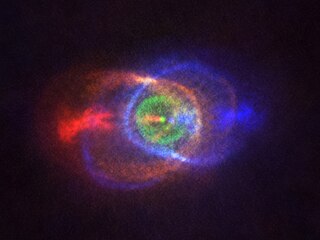Related Research Articles
A Thorne–Żytkow object, also known as a hybrid star, is a conjectured type of star wherein a red giant or red supergiant contains a neutron star at its core, formed from the collision of the giant with the neutron star. Such objects were hypothesized by Kip Thorne and Anna Żytkow in 1977. In 2014, it was discovered that the star HV 2112, located in the Small Magellanic Cloud (SMC), was a strong candidate. Another possible candidate is the star HV 11417, also located in the SMC.

A protoplanetary nebula or preplanetary nebula is an astronomical object which is at the short-lived episode during a star's rapid evolution between the late asymptotic giant branch (LAGB)[a] phase and the subsequent planetary nebula (PN) phase. A PPN emits strongly in infrared radiation, and is a kind of reflection nebula. It is the second-from-the-last high-luminosity evolution phase in the life cycle of intermediate-mass stars.
The Hungarian Automated Telescope Network (HATNet) project is a network of six small fully automated "HAT" telescopes. The scientific goal of the project is to detect and characterize extrasolar planets using the transit method. This network is used also to find and follow bright variable stars. The network is maintained by the Center for Astrophysics | Harvard & Smithsonian.

NGC 1851 is a relatively massive globular cluster located in the southern constellation of Columba. Astronomer John Dreyer described it as not very bright but very large, round, well resolved, and clearly consisting of stars. It is located 39.5 kilolight-years from the Sun, and 54.1 kilolight-years from the Galactic Center. The cluster is following a highly eccentric orbit through the galaxy, with an eccentricity of about 0.7.

Planet Hunters is a citizen science project to find exoplanets using human eyes. It does this by having users analyze data from the NASA Kepler space telescope and the NASA Transiting Exoplanet Survey Satellite. It was launched by a team led by Debra Fischer at Yale University, as part of the Zooniverse project.

An exocomet, or extrasolar comet, is a comet outside the Solar System, which includes rogue comets and comets that orbit stars other than the Sun. The first exocomets were detected in 1987 around Beta Pictoris, a very young A-type main-sequence star. There are now a total of 27 stars around which exocomets have been observed or suspected.
Kepler-45, formerly known as KOI-254, is a star in the northern constellation of Cygnus. It is located at the celestial coordinates: right ascension 19h 31m 29.495s, declination +41° 03′ 51.37″. With an apparent visual magnitude of 16.88, this star is too faint to be seen with the naked eye.
WD 1145+017 is a white dwarf approximately 476 light-years from Earth in the constellation of Virgo. It is the first white dwarf to be observed with a transiting minor planet orbiting it.
Kepler-84 is a Sun-like star 4,700 light-years from the Sun. It is a G-type star. The stellar radius measurement has a large uncertainty of 48% as in 2017, complicating the modelling of the star. The Kepler-84 star has two suspected stellar companions. Four red dwarfs are few arcseconds away and at least one is probably gravitationally bound to Kepler-84. Another is a yellow star of mass 0.855M☉ on projected separations of 0.18±0.05″ or 0.26″.

iPTF14hls is an unusual supernova star that erupted continuously for about 1,000 days beginning in September 2014 before becoming a remnant nebula. It had previously erupted in 1954. None of the theories nor proposed hypotheses fully explain all the aspects of the object.

Heartbeat stars are pulsating variable binary star systems in eccentric orbits with vibrations caused by tidal forces. The name "heartbeat" comes from the similarity of the light curve of the star with what a heartbeat looks like through an electrocardiogram if their brightness was mapped over time. Many heartbeat stars have been discovered with the Kepler Space Telescope.

A post-common envelope binary (PCEB) or pre-cataclysmic variable is a binary system consisting of a white dwarf or hot subdwarf and a main-sequence star or a brown dwarf. The star or brown dwarf shared a common envelope with the white dwarf progenitor in the red giant phase. In this scenario the star or brown dwarf loses angular momentum as it orbits within the envelope, eventually leaving a main-sequence star and white dwarf in a short-period orbit. A PCEB will continue to lose angular momentum via magnetic braking and gravitational waves and will eventually begin mass-transfer, resulting in a cataclysmic variable. While there are thousands of PCEBs known, there are only a few eclipsing PCEBs, also called ePCEBs. Even more rare are PCEBs with a brown dwarf as the secondary. A brown dwarf with a mass lower than 20 MJ might evaporate during the common envelope phase and therefore the secondary is supposed to have a mass higher than 20 MJ.

13 Ceti is a triple star system in the equatorial constellation of Cetus. It is dimly visible to the naked eye with a combined apparent visual magnitude of 5.20. The system is located at a distance of approximately 69 light years from the Sun based on stellar parallax, and is drifting further away with a radial velocity of +10.4 km/s. It shares a common motion with the Hyades moving group, although it is too old to be a member.
Kepler-429 is a variable subdwarf B star in the constellation Lyra, about 5,900 light years away.
TESS Hunt for Young and Maturing Exoplanets (THYME) is an exoplanet search project. The researchers of the THYME collaboration are mainly from the United States and search for young exoplanets using data from the Transiting Exoplanet Survey Satellite (TESS). The new discoveries should help to understand the early evolution of exoplanets. As of March 2023 the collaboration produced 9 papers announcing the discovery of exoplanets.
Common envelope jets supernova (CEJSN) is a type of supernova, where the explosion is caused by the merger of a giant or supergiant star with a compact star such as a neutron star or a black hole. As the compact star plunges into the envelope of the giant/supergiant, it begins to accrete matter from the envelope and launches jets that can disrupt the envelope. Often, the compact star eventually merges with the core of the giant/supergiant; other times the infall stops before core merger.
References
- ↑ MIT faculty directory
- ↑ "Astronomers cite X-rays in a star". The Telegraph. August 29, 1975. Retrieved July 16, 2011.
- ↑ "Scientists study puzzling X-ray". Tri City Herald. January 25, 1978. Retrieved July 16, 2011.
- ↑ Rappaport, S.; Vanderburg, A.; Jacobs, T.; Lacourse, D.; Jenkins, J.; Kraus, A.; Rizzuto, A.; Latham, D. W.; Bieryla, A.; Lazarevic, M.; Schmitt, A. (2018). "Likely transiting exocomets detected by Kepler". Monthly Notices of the Royal Astronomical Society. 474 (2): 1453–1468. arXiv: 1708.06069 . Bibcode:2018MNRAS.474.1453R. doi: 10.1093/mnras/stx2735 . PMC 5943639 . PMID 29755143.
- ↑ Rappaport, S.; Vanderburg, A.; Jacobs, T.; Lacourse, D.; Jenkins, J.; Kraus, A.; Rizzuto, A.; Latham, D. W.; Bieryla, A.; Lazarevic, M.; Schmitt, A. (2018). "Likely transiting exocomets detected by Kepler". Monthly Notices of the Royal Astronomical Society. 474 (2): 1453–1468. arXiv: 1708.06069 . Bibcode:2018MNRAS.474.1453R. doi: 10.1093/mnras/stx2735 . PMC 5943639 . PMID 29755143.
- ↑ "APS Fellow Archive". APS. Retrieved 5 October 2020.